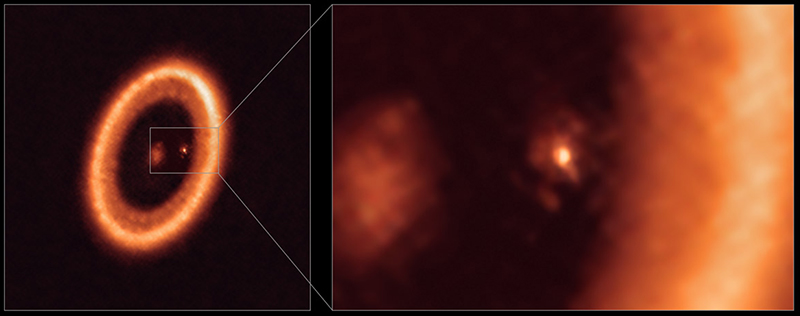In 2019, a team of astronomers caught the first hints of a young exoplanet surrounded by the right stuff to form satellites. Those hints now have been confirmed by high-resolution images that capture light from a potentially moon-forming swirl of dust that surrounds that planet.
The young planetary system, PDS 70, “is the first system where two growing planets, at least one with a circumplanetary disk, have been observed directly,” said Stefano Facchini, an astronomer at the European Southern Observatory and a coauthor of the recent discovery. “The circumplanetary disk around PDS 70 c today is the perfect environment to study the conditions of satellite formation.”
The Testing Grounds
It takes millions of years to form a planetary system from an interstellar cloud of gas and dust. Gravitational instabilities in a cloud will cause it to slowly collapse onto itself until the temperature at the center is hot enough to ignite a protostar. Most of the remaining material falls onto the star, and the remainder flattens out into a disk (called a circumstellar disk) that might, after millions more years, form planets.
This same process is thought to repeat itself on a smaller scale when planets try to form their own moons (instead of capturing them): After a young planet accumulates enough mass to carve out gaps in the circumstellar disk, dust and gas still surround the growing planet and can flatten out into a smaller disk around it. That circumplanetary disk can then coalesce into one or more satellites. The four Galilean moons of Jupiter are thought to have formed in this way, but the only way to prove that this mechanism forms moons is to catch it in the act.
Enter PDS 70, a star merely 5.4 million years old that is still surrounded by a circumstellar disk. Two gas giant planets that are still accumulating mass have so far been detected as they carve gaps and shape rings within the circumstellar disk.
Upon a closer look at the outer planet PDS 70 c, which is a few times Jupiter’s mass and orbits its protostar slightly farther than Neptune does from the Sun, astronomers detected a faint, fuzzy emission haloing it. They tentatively identified that fuzz as a circumplanetary disk. “The planet has already acquired most of its mass during its past evolution,” Facchini explained. “As for the moons, theoretical models show that satellite formation is possible precisely when the accretion rate onto the planet is low, of the order of what we are observing today.”

After that first identification 2 years ago, the team pushed to observe this still-forming planet and the satellites it could be growing. With the Atacama Large Millimeter/submillimeter Array (ALMA) in Chile, the team was able to capture high-resolution images of the entire PDS 70 system at wavelengths favored by planet-forming dust. When combined with previous observations, the images revealed that the dust surrounding PDS 70 c extends one Earth-to-Sun separation (1 astronomical unit) from the planet, about 4 times wider than Saturn’s rings. “Today the circumplanetary disk has a dust mass that is at least three Moon masses,” Facchini said, “but during the remaining lifetime much more dust mass can be acquired by the system,” maybe as much as an Earth mass of material. The team published this discovery in Astrophysical Journal Letters on 22 July.
Up Next: What Moons Are Made Of
“Our work presents a clear detection of a disc in which satellites could be forming,” lead author Myriam Benisty of the University of Grenoble in France and the University of Chile said in a statement. “Our ALMA observations were obtained at such exquisite resolution that we could clearly identify that the disc is associated with the planet and we are able to constrain its size for the first time.”
Long predicted, this seems like the first really robust observation of a circumplanetary disk busy (perhaps) making exomoons…simply fabulous data from ESO https://t.co/TGtPTNjMNl
— Caleb Scharf (@caleb_scharf) July 22, 2021
So far, the team has been able to measure the dust component of the circumstellar and circumplanetary disks. However, there might be 100 or 1,000 times more gas than dust in the disk that hasn’t yet been mapped. The team is currently using ALMA to study how that gas moves throughout the system, Facchini said. With ALMA and also future observatories, the researchers hope to determine the chemical composition of the material that is forming the atmospheres of PDS 70 c, the inner planet PDS 70 b, and any moons that may be growing around them.
—Kimberly M. S. Cartier (@AstroKimCartier), Staff Writer






